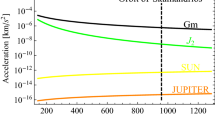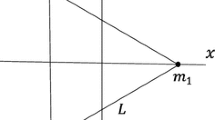Abstract
Starting from the four-body problem a generalization of both the restricted three-body problem and the Hill three-body problem is derived. The model is time periodic and contains two parameters: the mass ratio ν of the restricted three-body problem and the period parameter m of the Hill Variation orbit. In the proper coordinate frames the restricted three-body problem is recovered as m → 0 and the classical Hill three-body problem is recovered as ν → 0. This model also predicts motions described by earlier researchers using specific models of the Earth–Moon–Sun system. An application of the current model to the motion of a spacecraft in the Sun perturbed Earth–Moon system is made using Hill's Variation orbit for the motion of the Earth–Moon system. The model is general enough to apply to the motion of an infinitesimal mass under the influence of any two primaries which orbit a larger mass.
Using the model, numerical investigations of the structure of motions around the geometric position of the triangular Lagrange points are performed. Values of the parameter ν range in the neighborhood of the Earth–Moon value as the parameter m increases from 0 to 0.195 at which point the Hill Variation orbit becomes unstable. Two families of planar periodic orbits are studied in detail as the parameters m and ν vary. These families contain stable and unstable members in the plane and all have the out-of-plane stability. The stable and unstable manifolds of the unstable periodic orbits are computed and found to be trapped in a geometric area of phase space over long periods of time for ranges of the parameter values including the Earth–Moon–Sun system.
This model is derived from the general four-body problem by rigorous application of the Hill and restricted approximations. The validity of the Hill approximation is discussed in light of the actual geometry of the Earth–Moon–Sun system.
Similar content being viewed by others
References
Hénon, M.: 1969, ‘Numerical Exploration of the Restricted Problem. V.’, Astron. Astrophys. 1, 223–238.
Hénon M. and Petit, J.-M.: 1986, ‘Series Expansions for Hill's Problem’, Celest. Mech. 38, 67–100.
Kamel, A. A. and Breakwell, J. V.: 1970, ‘Stability of Motion Near Sun-Perturbed Earth–Moon Triangular Libration Points’, Periodic Orbits, Stability and Resonances, 82–90.
Kolenkiewicz, R. and Carpenter, L.: 1968, ‘Stable Periodic Orbits about the Sun-Perturbed Earth–Moon Triangular Points’, AIAA J. 6(7), 1301–1304.
Marchal, C.: 1990, The Three-Body Problem, Elsevier, pp. 162–163.
Schechter, H. B.: 1968, ‘Three-Dimensional Nonlinear Stability Analysis of the Sun-Perturbed Earth–Moon Equilateral Points’, AIAA J. 6(7), 1223–1228.
Wintner, A.: 1947, The Analytical Foundations of Celestial Mechanics, Princeton University Press, pp. 379–410.
Author information
Authors and Affiliations
Rights and permissions
About this article
Cite this article
Scheeres, D.J. The Restricted Hill Four-Body Problem with Applications to the Earth–Moon–Sun System. Celestial Mechanics and Dynamical Astronomy 70, 75–98 (1998). https://doi.org/10.1023/A:1026498608950
Issue Date:
DOI: https://doi.org/10.1023/A:1026498608950




